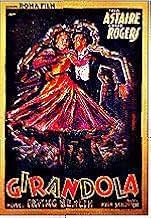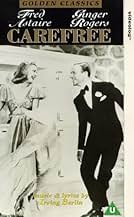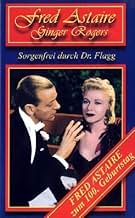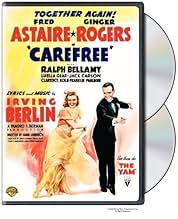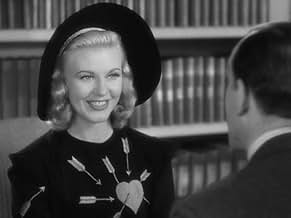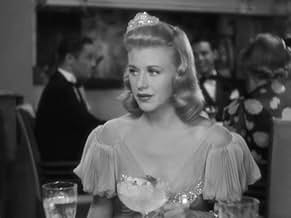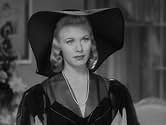IMDb RATING
6.9/10
4.5K
YOUR RATING
A psychiatrist falls in love with the woman he's supposed to be nudging into marriage with someone else.A psychiatrist falls in love with the woman he's supposed to be nudging into marriage with someone else.A psychiatrist falls in love with the woman he's supposed to be nudging into marriage with someone else.
- Nominated for 3 Oscars
- 3 wins & 4 nominations total
The Robert Mitchell Boy Choir
- Vocal Ensemble
- (scenes deleted)
- (as Robert B. Mitchell and his St. Brendan's Boys)
Harry A. Bailey
- Sponsor
- (uncredited)
Bobby Barber
- Minor Role
- (uncredited)
Cliff Bergere
- Minor Role
- (uncredited)
Ralph Brooks
- Country Club Guest
- (uncredited)
James P. Burtis
- Glass Truck Driver
- (uncredited)
Harry Campbell
- Minor Role
- (uncredited)
James Carlisle
- Country Club Guest
- (uncredited)
Charles Coleman
- Doorman
- (uncredited)
Featured reviews
On my first viewing of Carefree, I experienced something I never thought I would with Fred and Ginger, boredom. Initially I was expecting another spectacular musical showcase, however, the film is on a smaller scale (their shortest at only 80 minutes) than their previous outings and only contains a mere four musical numbers; making it more of a comedy with some singing and dancing than a full-fledged musical. With several movies behind them following a similar formula, if they were going to make another then they had to do something different or things would have become stale. I wished though that Fred Astaire could have done straight comedies during his career; Carefree is the closest thing to that.
None of the musical numbers in Carefree stand out as being among the best in the series. Fred Astaire's number in which he plays golf while tap dancing sounds better on paper than it does in execution. I'm sure what he's doing is no easy task yet it doesn't look all that impressive to watch. The Yam, on the other hand, is a pretty standard number, but heck, it's still Fred and Ginger dancing. I find the film's most interest musical number is 'I Used to be Color Blind', the most experimental in the film, shot in slow motion and allowing the viewer to see Fred and Ginger's grace in every detail.
For the only time in the series, Astaire plays a character who is not a dancer by profession, but rather a psychiatrist (although they do make sure to mention he once had aspirations of becoming a dancer). I don't completely buy Astaire as a psychiatrist, but realism is not what these movies are about. Plus I'm sure the psychology on display here is of the "you are getting sleepy" variety as seen in movies. He doesn't break his professional ethics though by pursuing his patient like his stalkerish attitude towards Ginger in other films in the series, instead, she wants him.
Carefree belongs to Ginger, playing a character whom has been put under hypnosis, giving her the opportunity to completely goof around in a childlike manner with big wide eyes, and it's pretty funny stuff. How many movies do you get to see Ginger Rogers wielding a shotgun? Everyone needs at least one movie where they get to act stupid. The comedic assets of Ralph Bellamy and Jack Carson are big benefits to the film's witty dialogue, where much of the film's strength lies. Even if the dance numbers don't fully exceed, as a screwball comedy, Carefree grows on me, of course, I am a sucker for these movies and the Astaire/Rodgers name, so good enough for me!
None of the musical numbers in Carefree stand out as being among the best in the series. Fred Astaire's number in which he plays golf while tap dancing sounds better on paper than it does in execution. I'm sure what he's doing is no easy task yet it doesn't look all that impressive to watch. The Yam, on the other hand, is a pretty standard number, but heck, it's still Fred and Ginger dancing. I find the film's most interest musical number is 'I Used to be Color Blind', the most experimental in the film, shot in slow motion and allowing the viewer to see Fred and Ginger's grace in every detail.
For the only time in the series, Astaire plays a character who is not a dancer by profession, but rather a psychiatrist (although they do make sure to mention he once had aspirations of becoming a dancer). I don't completely buy Astaire as a psychiatrist, but realism is not what these movies are about. Plus I'm sure the psychology on display here is of the "you are getting sleepy" variety as seen in movies. He doesn't break his professional ethics though by pursuing his patient like his stalkerish attitude towards Ginger in other films in the series, instead, she wants him.
Carefree belongs to Ginger, playing a character whom has been put under hypnosis, giving her the opportunity to completely goof around in a childlike manner with big wide eyes, and it's pretty funny stuff. How many movies do you get to see Ginger Rogers wielding a shotgun? Everyone needs at least one movie where they get to act stupid. The comedic assets of Ralph Bellamy and Jack Carson are big benefits to the film's witty dialogue, where much of the film's strength lies. Even if the dance numbers don't fully exceed, as a screwball comedy, Carefree grows on me, of course, I am a sucker for these movies and the Astaire/Rodgers name, so good enough for me!
Hilarious and very stylish, this spellbinding art moderne musical is a real experiment in RKO craftsmanship. Did you know the dream sequences to the song "I used to be color blind" were originally filmed in color but the release abandoned because RKO couldn't get the tech specs right and the cost was going to be too high for the budget already set. It was a great idea and today might have made CAREFREE a more enduring success as there is no color footage of them as a dancing pair until 1949 at MGM.. Apart from the snazzy look of the art direction, Ginger's fantastic 'hearts and arrows' outfit and big black bewitching hat and the RKO world of the stone and timber country club, the music here is just terrific. The swing antics of the golf club bagpipe sequence had one audience I saw it with in rapturous applause. But I defy anyone to stay seated during THE YAM as they wing and swing their way all over the BIG SET Country club. CAREFREE is just great.
this is one of my favorite fred astaire/ginger rogers films. it's highly amusing how she toys with him at the beginning of the film, and then once he begins hypnosis, they have one of the best dance scenes i've ever seen between them. as always, their magic together is astounding.
CAREFREE (RKO Radio, 1938), directed by Mark Sandrich, a screwball comedy set to music, reunites the song and dance team of Fred Astaire and Ginger Rogers for the eighth time in a sort of welcome change from their previous efforts: Astaire plays a doctor, psychiatrist by profession, rather than his usual lovesick American dancer, although the doctor in question DOES have a talent for dancing. Rogers, breaking away from sophisticated humor, makes her mark in broader comedy. She's been funny before, usually sassy with nifty comebacks, but this time in the dizzy-dame mode, but fortunately, not to the extreme.
The plot focuses on Stephen Arden (Ralph Bellamy), a witless attorney. He becomes drunk after his engagement to popular radio star, Amanda Cooper (Ginger Rogers), has been broken for the third time and stumbles to the Medical Foundation building to ask his good friend, Dr. Tony Flagg (Fred Astaire), a psychiatrist assisted by his white coated Connors (Jack Carson), to have Amanda "what's 'er name" analyzed. While waiting in his office, Amanda, accidentally stumbles upon Flagg's phonograph record, listening to a diagnosis about his last patient, closing with his comment about his next patient, Miss Cooper, being a "maladjusted woman." Upset, Amanda turns the tables around by sitting behind his desk and the doctor uncomfortably on the other end in a question and answer session. While bicycling in the park with Steven and her Aunt Cora (Luella Gaer), Amanda and Tony meet again, coming come to friendly terms. Agreeing to Tony's treatments, Amanda goes through a dinner special diet (lobster with mayonnaise and buttermilk) so to have her dreams analyzed, and hypnotism that turns to disaster when roaming the streets in a trance.
With plenty of comedy written into the screenplay, it's a wonder how dance numbers could fit into an overall "screwball" comedy, especially with a score by Irving Berlin. This is where CAREFREE stands apart from the other Astaire and Rogers films. The first number, "Since They Turned 'Loch Lamond' Into Swing" finds Astaire at a golf course accomplishing several things at the same time by playing the harmonica and tap dancing to a Scottish underscoring while teeing off several golf balls in rhythm, all to perfection without once missing his mark. There is no vocal to this number. "I Used to Be Color Blind" is very interesting mainly because it takes part as Rogers' dream dance, with Astaire, singing and dancing in slow motion. While "The Yam" sung by Ginger Rogers at the country club, is an upbeat number, followed by dancing with Astaire on wooden floors rather than the traditional glossy ones. It didn't become a memorable duet as "The Carioca," "The Continental" or "The Piccolino," but unlike these earlier dance numbers, which Fred and Ginger are the main focus, they invite dinner guests to join in with them. The final number, "Change Partners," a more appropriate title than "Carefree," is a beautiful love dance, or trance dance, where the hypnotized Rogers dances in a motionless manner with Astaire. While "Change Partners" is in slower tempo, it's one of the film's most memorable tune, it not, their most sentimental dance sequences. "Change Partners" earned an Academy Award nomination as Best Song.
Luella Gear, as Rogers' matron aunt, Cora, comes across as a middle-aged Kay Francis but speaking like Helen Broderick. Gear, in her movie debut, had very few films to her credit. She's reportedly best known for her role as Aunt Hortence in the stage version of THE GAY DIVORCE (1932) that starred Astaire. Ralph Bellamy, who by this time was usually type-cast as stuffy suitors, happens to be the most masculine of Rogers' rejected beaus thus far. His character, however, becomes very unlikable towards the second half, bogging down the story.
Rounding out the cast in smaller roles are Franklin Pangborn (Roland Hunter); and Hattie McDaniel (Hattie, the maid); and Kay Sutton (Miss Adams). Clarence Kolb takes support as the no-nonsense Judge Joe Travers, Stephen's friend who pleasure himself by telling corny jokes. Although credited, the Robert B. Mitchell and the St. Brendan's Boy Choir seem to have become victims of the editing process consider how they're nowhere to be seen, only heard on the soundtrack singing "Change Partners" near the film's close.
In spite of numerous pros and cons, CAREFREE ranks the team's most underrated film as shortest (83 minutes). It's occasionally funny in spots with imaginable, if not too successful, dance numbers. Other than CAREFREE being available on video cassette and DVD, and formerly found on American Movie Classics prior to 2001, it turns up occasionally (with close casting credits restored) on Turner Classic Movies. Next in the Astaire and Rogers series, THE STORY OF VERNON AND IRENE CASTLE (1939). (***)
The plot focuses on Stephen Arden (Ralph Bellamy), a witless attorney. He becomes drunk after his engagement to popular radio star, Amanda Cooper (Ginger Rogers), has been broken for the third time and stumbles to the Medical Foundation building to ask his good friend, Dr. Tony Flagg (Fred Astaire), a psychiatrist assisted by his white coated Connors (Jack Carson), to have Amanda "what's 'er name" analyzed. While waiting in his office, Amanda, accidentally stumbles upon Flagg's phonograph record, listening to a diagnosis about his last patient, closing with his comment about his next patient, Miss Cooper, being a "maladjusted woman." Upset, Amanda turns the tables around by sitting behind his desk and the doctor uncomfortably on the other end in a question and answer session. While bicycling in the park with Steven and her Aunt Cora (Luella Gaer), Amanda and Tony meet again, coming come to friendly terms. Agreeing to Tony's treatments, Amanda goes through a dinner special diet (lobster with mayonnaise and buttermilk) so to have her dreams analyzed, and hypnotism that turns to disaster when roaming the streets in a trance.
With plenty of comedy written into the screenplay, it's a wonder how dance numbers could fit into an overall "screwball" comedy, especially with a score by Irving Berlin. This is where CAREFREE stands apart from the other Astaire and Rogers films. The first number, "Since They Turned 'Loch Lamond' Into Swing" finds Astaire at a golf course accomplishing several things at the same time by playing the harmonica and tap dancing to a Scottish underscoring while teeing off several golf balls in rhythm, all to perfection without once missing his mark. There is no vocal to this number. "I Used to Be Color Blind" is very interesting mainly because it takes part as Rogers' dream dance, with Astaire, singing and dancing in slow motion. While "The Yam" sung by Ginger Rogers at the country club, is an upbeat number, followed by dancing with Astaire on wooden floors rather than the traditional glossy ones. It didn't become a memorable duet as "The Carioca," "The Continental" or "The Piccolino," but unlike these earlier dance numbers, which Fred and Ginger are the main focus, they invite dinner guests to join in with them. The final number, "Change Partners," a more appropriate title than "Carefree," is a beautiful love dance, or trance dance, where the hypnotized Rogers dances in a motionless manner with Astaire. While "Change Partners" is in slower tempo, it's one of the film's most memorable tune, it not, their most sentimental dance sequences. "Change Partners" earned an Academy Award nomination as Best Song.
Luella Gear, as Rogers' matron aunt, Cora, comes across as a middle-aged Kay Francis but speaking like Helen Broderick. Gear, in her movie debut, had very few films to her credit. She's reportedly best known for her role as Aunt Hortence in the stage version of THE GAY DIVORCE (1932) that starred Astaire. Ralph Bellamy, who by this time was usually type-cast as stuffy suitors, happens to be the most masculine of Rogers' rejected beaus thus far. His character, however, becomes very unlikable towards the second half, bogging down the story.
Rounding out the cast in smaller roles are Franklin Pangborn (Roland Hunter); and Hattie McDaniel (Hattie, the maid); and Kay Sutton (Miss Adams). Clarence Kolb takes support as the no-nonsense Judge Joe Travers, Stephen's friend who pleasure himself by telling corny jokes. Although credited, the Robert B. Mitchell and the St. Brendan's Boy Choir seem to have become victims of the editing process consider how they're nowhere to be seen, only heard on the soundtrack singing "Change Partners" near the film's close.
In spite of numerous pros and cons, CAREFREE ranks the team's most underrated film as shortest (83 minutes). It's occasionally funny in spots with imaginable, if not too successful, dance numbers. Other than CAREFREE being available on video cassette and DVD, and formerly found on American Movie Classics prior to 2001, it turns up occasionally (with close casting credits restored) on Turner Classic Movies. Next in the Astaire and Rogers series, THE STORY OF VERNON AND IRENE CASTLE (1939). (***)
The upper-class Stephen Arden (Ralph Bellamy) brings his fiancée, the radio singer Amanda Cooper (Ginger Rogers), to be consulted by his friend, the psychoanalyst Dr. Tony Flagg (Fred Astaire), to improve their relationship. Amanda listens to the record made by Dr. Flagg about her and has an initial friction with the shrink. But sooner she falls in love with him and discloses her feelings to Dr. Flagg. He decides to hypnotize Amanda to loath him and love Stephen. However his subconscious makes him perceive that he also loves Amanda. But Stephen obtains a restrain order against his friend and he can not get close to Amanda to withdrawal his former hypnotic suggestion.
"Carefree" is a delightfully naive and adorable classic, with a silly story but wonderful dance numbers of the constant pair Fred Astaire and Ginger Rogers. Ginger "steals" the film not only dancing, but also with a funny performance. My vote is seven.
Title (Brazil): "Dance Comigo" ("Dance with Me")
"Carefree" is a delightfully naive and adorable classic, with a silly story but wonderful dance numbers of the constant pair Fred Astaire and Ginger Rogers. Ginger "steals" the film not only dancing, but also with a funny performance. My vote is seven.
Title (Brazil): "Dance Comigo" ("Dance with Me")
Did you know
- TriviaThis was the first Fred Astaire-Ginger Rogers film to lose money on its initial release. It lost $68,000 (~ $1.48M in 2024) for RKO according to studio records.
- GoofsAs Amanda (Ginger Rogers) exits the taxicab and starts to cross the street for the theatre, you can see the reflection of the roof line behind her in the large piece of plate glass on the truck. On the roof line, you can see the rigging pipes for lights and other equipment showing it's a back lot set.
- Quotes
Stephen Arden: [drunkenly] Oh, uh, could you give me a little information?
Doorman: Yes sir.
Stephen Arden: Thank you.
[walks away]
- Crazy creditsDuring opening credits, a pair of hands finger-paints names, pauses, wipes them out, and writes the next set of names several times.
- ConnectionsFeatured in Fred Astaire: Puttin' on His Top Hat (1980)
- SoundtracksSince They Turned Loch Lomond into Swing
(1938) (uncredited)
Music by Irving Berlin
Danced by Fred Astaire
- How long is Carefree?Powered by Alexa
Details
Box office
- Budget
- $1,253,000 (estimated)
- Runtime
- 1h 23m(83 min)
- Color
- Aspect ratio
- 1.37 : 1
Contribute to this page
Suggest an edit or add missing content

